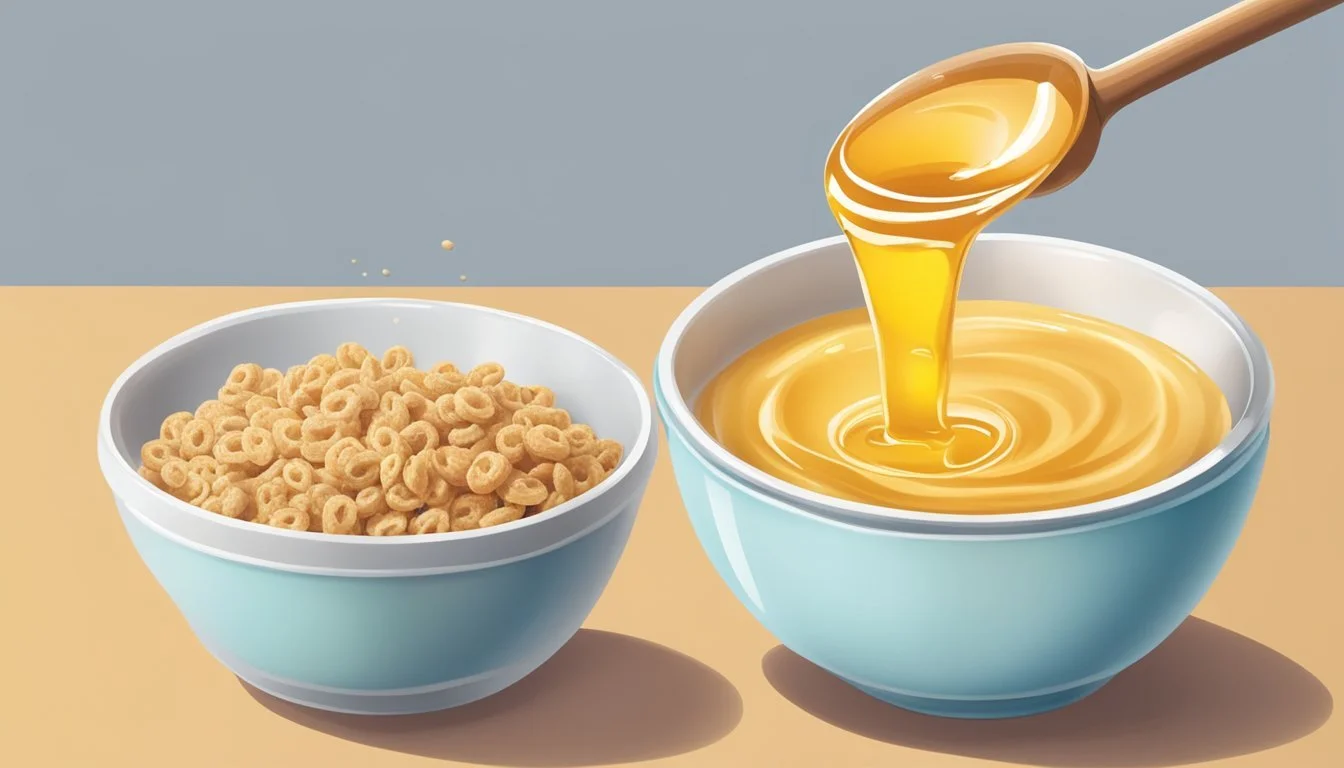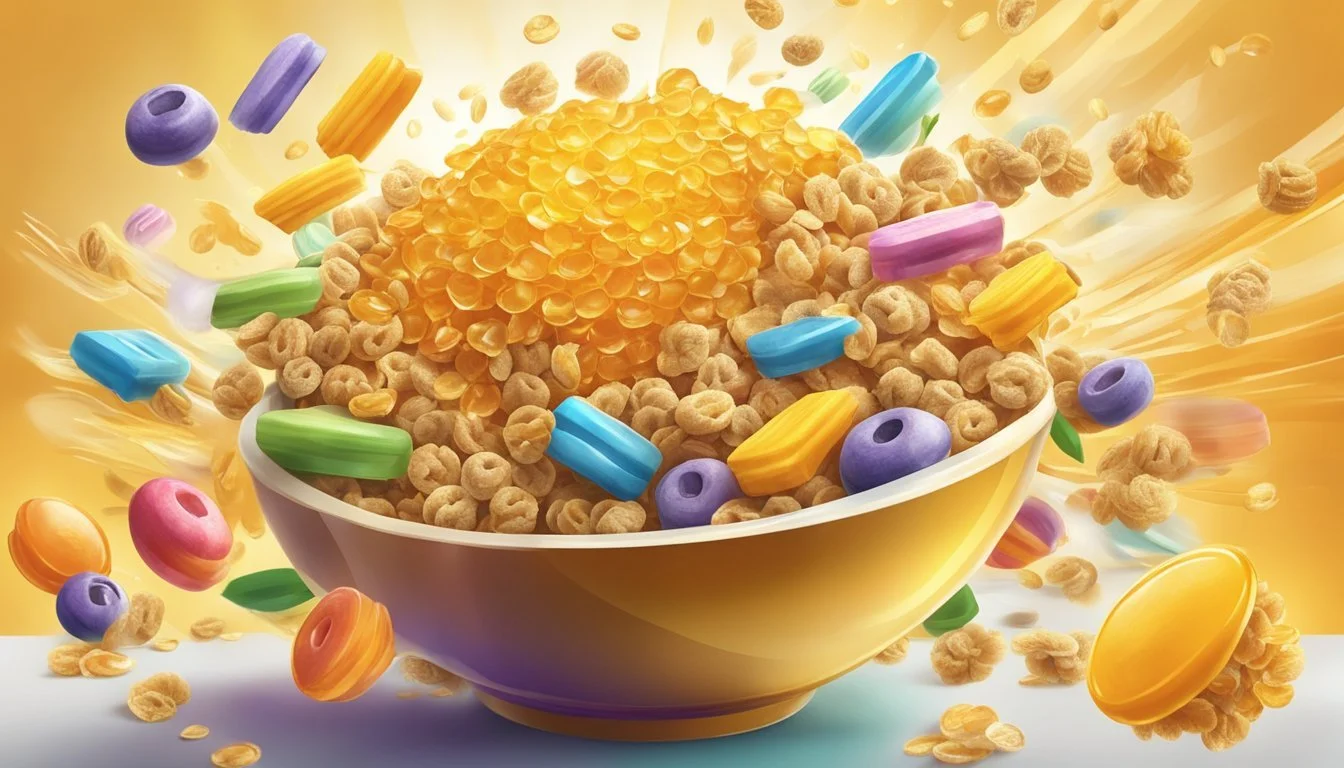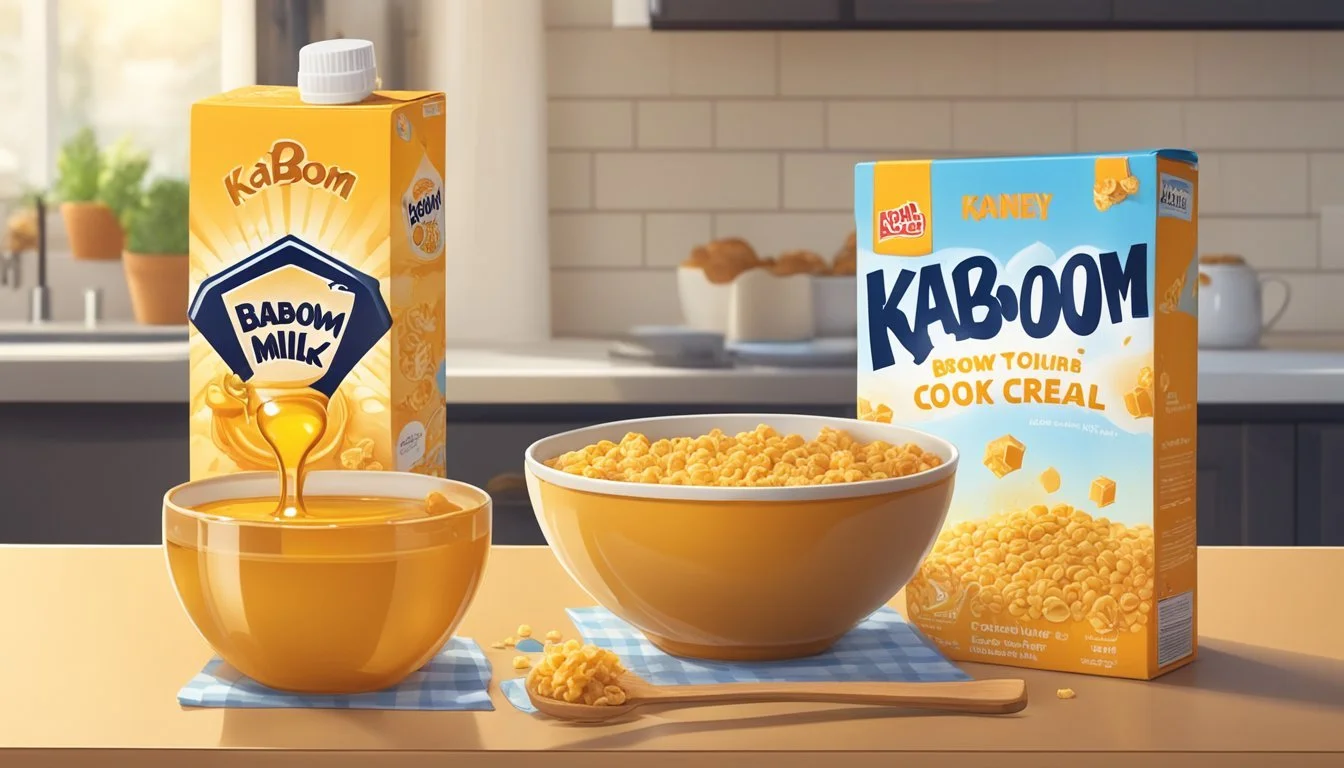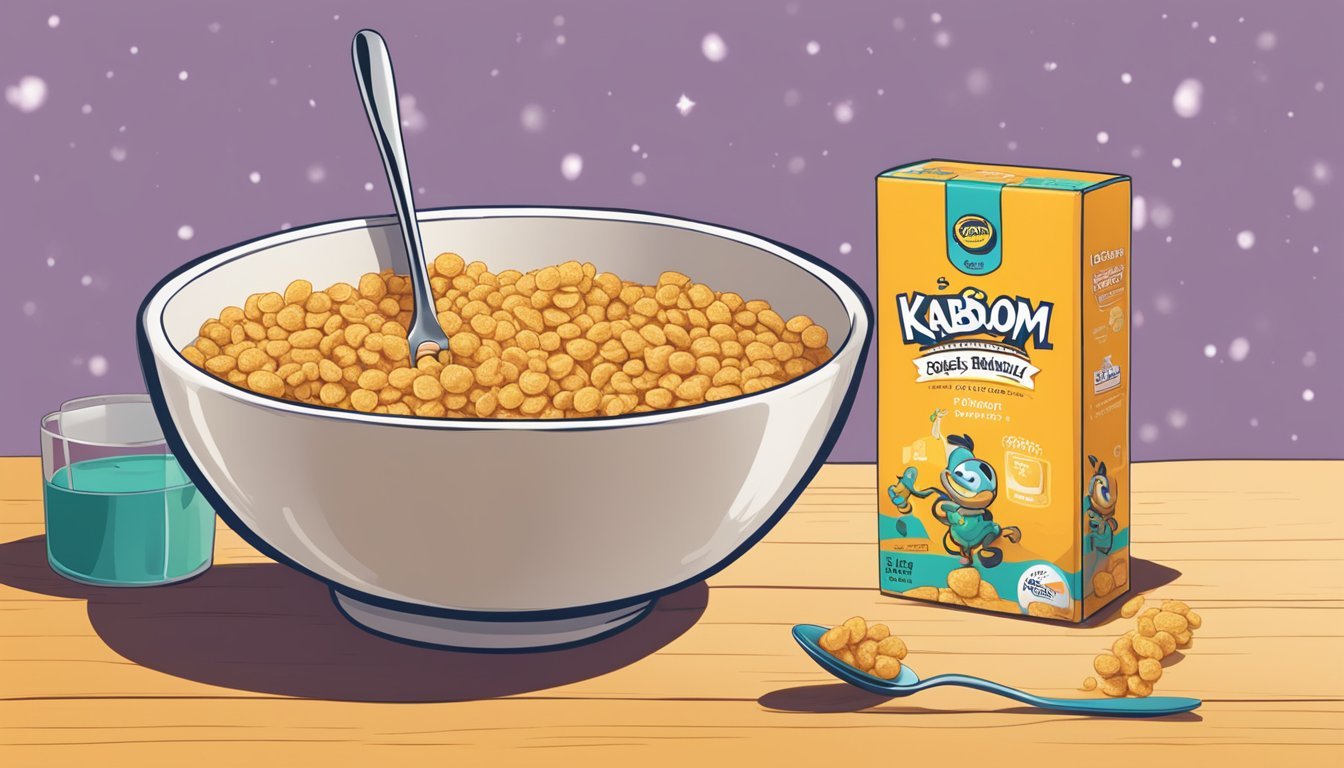Honey Ohs! vs Kaboom
Comparing Two Classic Cereals
This Article is Part of Our Breakfast Cereal Guide with Details on Honey Ohs! Nutrition and Kaboom Nutrition
Choosing the right breakfast cereal can be a daunting task with so many options available. Honey Ohs! and Kaboom are two iconic cereals that have captivated taste buds for generations. Both offer unique flavors and nostalgic appeal, but how do they measure up against each other?
Honey Ohs! delivers the sweet taste of graham crackers combined with real honey, creating a delightful crunch that many have come to love. Originally introduced by the Quaker Oats Company, it has a storied history and remains a popular choice under the Post Cereals brand today. Kaboom, on the other hand, is known for its colorful, circus-themed shapes and sweetened corn flavor. It has a playful aesthetic that appeals particularly to children and those seeking a fun breakfast experience.
When it comes to nutrition, Honey Ohs! provide a slightly more wholesome option with the inclusion of real honey and graham crackers. Kaboom, while enjoyable, tends to be more sugary, making it less suitable for those conscious about their sugar intake. Ultimately, the decision between Honey Ohs! and Kaboom boils down to personal preference and nutritional priorities.
Overview of Honey Ohs! and Kaboom
Honey Ohs! and Kaboom are two distinct products catering to different markets: one is a breakfast cereal and the other is a bathroom cleaner. Understanding their history, evolution, and reception can offer insights into their market positions.
Brand History
Honey Ohs! originally entered the market under the Quaker brand and has been a household name for breakfast cereals. In August 2014, production shifted to Post, a major player in the cereal industry.
Kaboom is recognized in the cleaning industry for its effectiveness in removing tough stains, mold, and mildew. The product is well-known for its strong formulation and powerful cleaning capabilities.
Product Evolution
Honey Ohs! has maintained a consistent formula despite changes in ownership, focusing on its signature honey taste and crunch. The product underwent a rebranding phase but retained its key characteristics, ensuring consumer loyalty.
Kaboom also evolved, with variations introduced over time, such as its Foam-Tastic cleaner. The formula has seen improvements to cater to modern cleaning needs, including enhancements in stain removal efficacy.
Market Reception
Honey Ohs! has seen consistent popularity, appreciated for its flavor and crunchy texture. Despite the transition from Quaker to Post, consumer acceptance remained high.
Kaboom enjoys a strong market presence due to its proven cleaning power and reliability. It stands out in the competitive landscape of bathroom cleaners with its ability to tackle difficult stains effectively.
Nutritional Comparison
Honey Ohs! and Kaboom cereals differ significantly across their ingredient profiles, vitamin and mineral contents, dietary fiber, sugars, and caloric values.
Ingredient Profile
Honey Ohs! contains ingredients like corn, whole grain oats, oat flour, brown sugar, honey, and graham flour. These ingredients contribute to its sweet taste and texture. On the other hand, Kaboom is made primarily from corn flour, rice flour, sugar, and molasses.
Kaboom uses artificial flavors and colors more extensively compared to Honey Ohs!, which focuses on natural sweeteners. The presence of whole grains in Honey Ohs! such as whole grain oats provides a nutritional edge over Kaboom, making it a more wholesome choice.
Vitamin and Mineral Content
Honey Ohs! is fortified with various vitamins and minerals. It is a good source of iron (68% DV) and typically includes added vitamins like Vitamin D, Vitamin C, and Vitamin B12.
Kaboom cereal is also fortified but often includes different vitamins. Kaboom may lead in certain areas depending on the specific nutrients added, for example, higher amounts of Vitamin A and Calcium. Both cereals aim to meet daily nutritional requirements, but the exact values can vary, making it important to read the nutrition labels carefully.
Dietary Fiber and Sugars
Fiber content in Honey Ohs! can be attributed to its use of whole grain oats and graham flour, which generally provide a good amount of dietary fiber.
Kaboom, which includes more processed flour like corn and rice flour, usually has lower fiber content. Sugar content in both cereals is significant, with Honey Ohs! containing around 4.5 teaspoons of sugar per serving. Kaboom often has a similar or slightly higher sugar content due to its reliance on molasses and sugar for flavoring.
Caloric Value
Each serving of Honey Ohs! (about 40 grams or 1 cup) contains approximately 170 calories. The breakdown is roughly 83% carbs, 14% fat, and 3% protein.
Kaboom usually contains fewer calories per serving, often around 120-140 calories depending on serving size and fortifications. For those monitoring caloric intake, this might make Kaboom a slightly lower-calorie option. However, this difference should be balanced against other nutritional factors such as fiber and vitamin content.
In summary, Honey Ohs! provides more whole grains and higher fiber content, while Kaboom offers fewer calories per serving but potentially more artificial additives, impacting nutritional quality.
Flavor Profile and Variety
Honey Ohs! and Kaboom offer distinct and varied flavor experiences, with each cereal appealing to different taste preferences. This section breaks down the key aspects of their flavors, exploring how their taste compares, the role of flavor enhancers, and any unique flavors they bring to the table.
Comparison of Taste
Honey Ohs! presents a honey nut flavor that combines sweetness with a subtle nutty undertone. The cereal's crispy texture further enhances the appeal, creating a delightful crunch with every bite.
Kaboom, on the other hand, features a fruity flavor profile with apple cinnamon as its standout. The sweetness is balanced with a hint of spice, making it a flavorful contrast to Honey Ohs! Both cereals offer a burst of different yet complementary flavors that cater to diverse taste buds.
Flavor Enhancers
Both cereals use flavor enhancers to perfect their taste profiles. Honey Ohs! leverages the natural sweetness of honey, combined with the crunchy graham texture, to create a satisfying breakfast treat.
Kaboom incorporates natural and artificial apple cinnamon flavors, giving it a distinct and memorable taste. These enhancers not only amplify the primary flavors but also ensure that each bite delivers consistent and rich taste experiences, making both cereals favorites among their fans.
Unique Flavor Offerings
Honey Ohs! stands out with its blend of honey and nut flavors, complemented by hints of honey graham. This combination provides a unique taste that differentiates it from other breakfast cereals.
Kaboom offers a fruity adventure, with notable apple cinnamon highlights that add a spicy yet sweet dimension to the cereal. The addition of fruity bits adds to its unique flavor profile, making it a colorful and flavorful choice for those who enjoy variety in their morning bowl.
The variety in flavor profiles between Honey Ohs! and Kaboom ensures that there is an option for every palate, from the sweet and nutty to the fruity and spiced.
Texture and Quality
In comparing Honey Ohs! and Kaboom, texture and quality are critical factors that influence user satisfaction. The focus will be on crispiness and crunchiness, and how each product behaves once milk is introduced, considering elements such as protein and whole grain oats.
Crispiness and Crunchiness
Honey Ohs! are known for their light and crispy texture. The use of whole grain oats ensures each bite has a sturdy crunch. This initial crunchiness is enhanced by a honey glaze that contributes to a subtle, sweet crisp.
Kaboom, being a cleaning product line, does not have the same type of textural consideration. Instead, it focuses on delivering a foamy, effervescent action. While it's not applicable in the same edible sense, the "crunch" can be metaphorically linked to the product's scrubbing efficiency.
Texture After Milk Absorption
When Honey Ohs! are soaked in milk, they tend to soften while retaining some of their initial crispiness. The whole grain oats help maintain texture integrity longer compared to other cereals. This balance between softness and crunch provides a pleasant eating experience.
Kaboom, as a cleaning product, doesn't interact with milk. Its focus is on creating a texture effective for breaking down grime and dirt. The foaming action ensures thorough coverage, ensuring every nook and cranny is reached, providing a strong cleaning performance. Here, the texture is a key element in how the product performs its cleaning duties effectively.
The stark differences in their respective domains highlight distinct attributes related to texture and quality—one as a food product and the other as a household cleaner.
Brand Messaging and Advertising
Both Honey Ohs! and Kaboom cereals have distinct brand messaging strategies and advertising campaigns that target their respective audiences and highlight unique selling points.
Target Audience
Honey Ohs! and Kaboom are primarily marketed towards children and their parents. Honey Ohs! emphasizes wholesome ingredients and flavors with appeal to kids' taste buds through slogans like "Good things in the middle."
Kaboom, often remembered for its colorful shapes and sweet taste, is featured prominently in nostalgic marketing aimed at children. Parents are enticed by bold flavor profiles and fun shapes, making breakfast enjoyable and exciting for their kids.
Advertising Campaign Themes
Honey Ohs! leverages the concept of wholesome fun in its advertising. TV commercials often highlight how the cereal combines great taste with nutritious ingredients, reinforcing the idea of "Good things in the middle." This messaging ensures parents feel confident in choosing Honey Ohs! for their kids.
Kaboom's advertising campaigns focus on vibrant and fun experiences. TV commercials typically showcase its colorful appearance and playful shapes, aiming to captivate children's attention. Themes revolve around bringing joy to breakfast, emphasizing the entertaining and tasty aspects of Kaboom cereal.
Both brands use distinct themes to create memorable advertisements that resonate with their target audience, ensuring high recall and a compelling brand image.
Consumer Insights
Honey Ohs! and Kaboom have each carved a distinct niche in the breakfast cereal market. This section examines their consumer ratings, reviews, and repeat purchase behavior, providing key insights for potential buyers.
Customer Ratings and Reviews
Honey Ohs! often receives praise for its unique taste combination of graham and real honey. Reviews highlight the cereal's sweet, crunchy texture. On average, it garners high ratings in taste and overall satisfaction.
Kaboom, known for its colorful, fun shapes, appeals primarily to children. However, some reviews mention the cereal's high sugar content and artificial flavors as drawbacks. Price comparisons indicate that both cereals fall within a similar range, making taste preferences a more significant factor.
Repeat Purchase Behavior
Honey Ohs! shows strong repeat purchase behavior driven by flavor loyalty. Consumers often cite the cereal's distinct combination of textures and flavors as reasons for consistent repurchasing. Additionally, its relatively stable recipe has maintained customer trust over the years.
Kaboom, while popular among children, sees a somewhat lower repeat purchase rate among adults. The novelty factor appeals primarily to younger demographics, making it less likely for repeated buys among households without children. Price sensitivity also influences repeat purchases, although Kaboom's playful presentation appeals to its primary audience effectively.
Health Considerations
When comparing Honey Ohs! and Kaboom cereals, it's essential to evaluate their impact on health, focusing on allergy risks and diet compatibility.
Allergy and Sensitivity Information
Honey Ohs! contains potential allergens like wheat and corn, which can trigger reactions in those with specific sensitivities. Additionally, the presence of synthetic colors and flavors could be a factor for individuals with sensitivities to artificial additives.
Kaboom also poses allergy concerns, with ingredients such as cornmeal and sugar. Like Honey Ohs!, Kaboom includes synthetic colors and possibly other additives. Both cereals should be checked for possible cross-contamination with nuts or other allergens during manufacturing.
Consumers with known sensitivities should review ingredient lists carefully to avoid adverse reactions. Close attention to labeling can mitigate potential risks for those with allergies.
Suitability for Various Diets
For calorie-conscious consumers, Honey Ohs! offers around 170 calories per serving, with 3 grams of total fat. Sugar content is a concern, contributing to high glycemic load, which can impact blood sugar levels.
Kaboom has comparable calorie content but varying nutritional attributes. It may contain similar sugar levels, affecting energy stability and potentially leading to cravings.
Neither cereal is gluten-free, excluding it from suitable options for those with celiac disease or gluten intolerance.
Individuals on low-sugar diets might find both cereals unsatisfactory due to their high sugar content. Nutritional labeling should be reviewed to align them with personal dietary goals. More research may be necessary to identify better-suited alternatives.








